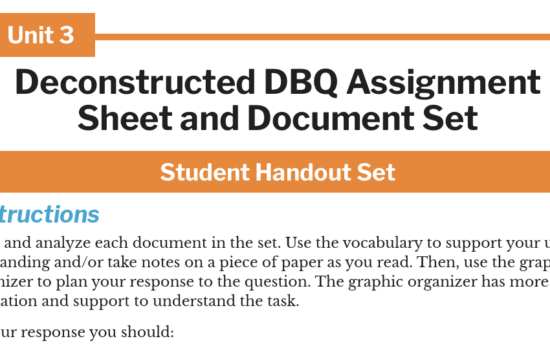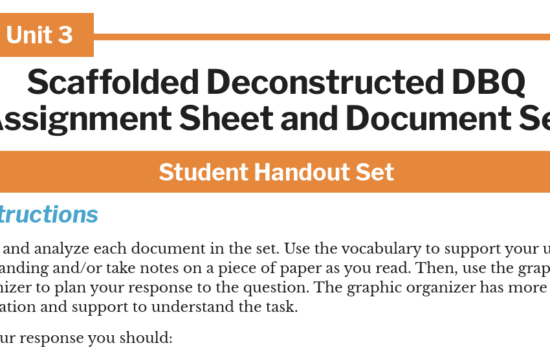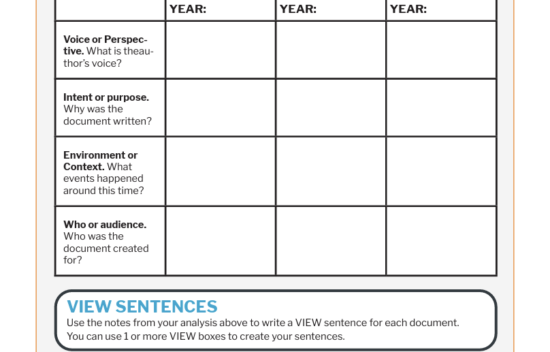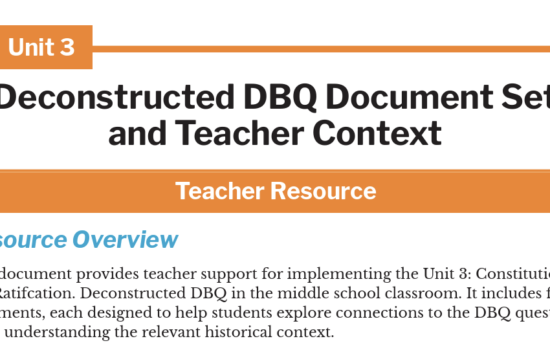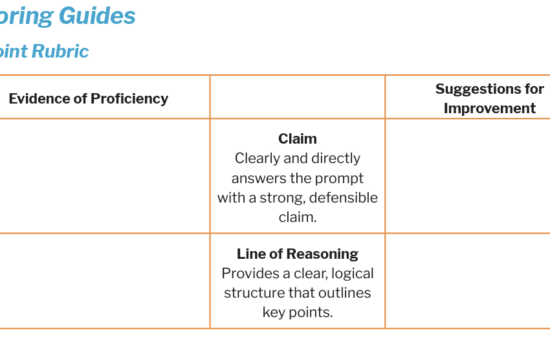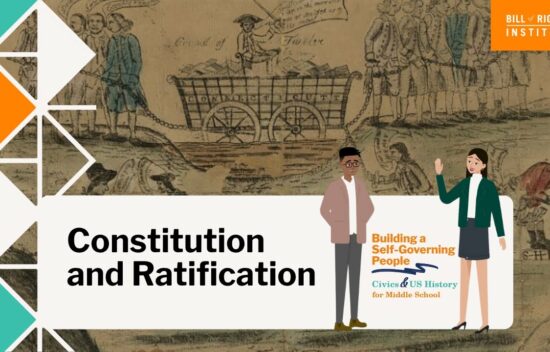
Unit 3: “VIEW”ing Documents Deconstructed DBQ – Mini-Lesson
Lesson Components
Guiding Question:
- What were the principles of the new Constitution and how did they shape the debate between the Federalists and Anti-Federalists during the ratification debate?
Objectives
- Students will analyze primary source documents to understand key historical events.
- Students will engage in critical thinking to interpret historical perspectives.
- Students will practice document analysis skills through the Game of Quotes activity.
- Students will develop a thesis statement using historical evidence.
Student Resources
Document Set (choose 1):
- Unit 3: Deconstructed DBQ Assignment Sheet and Document Set
- Unit 3: Scaffolded Deconstructed DBQ Assignment Sheet and Document Set
Graphic Organizer
Teacher Resources
Facilitation Notes
- This is a mini-lesson intended to take 30-45 minutes and focus on a specific skill. It accompanies the mini-lesson slide deck.
- The goal is to help students develop the skill of analyzing primary sources using the VIEW framework (Voice, Intent, Environment, Who).
- Common acronyms for primary source analysis include HIPP or HAPPY, but this lesson uses VIEW to structure analysis and writing.
- Encourage collaboration through discussion, peer review, and group activities.
Anticipate
Deconstructed DBQ Skill Video
- Assign, or watch as a whole group, the Deconstructed DBQ video for the unit.
- The video will introduce a new primary source from the time period, give historical context and analysis, and then lead students through using the source to answer the Deconstructed DBQ question with a thesis statement.
- Pause the video at the processing questions embedded in the video to prompt reflection and discussion.
Teacher Note: The Deconstructed DBQ videos work as a pre-teaching tool, but can also be used as a scaffolding support later in the mini-lesson. The video is based on a source not included in the Deconstructed DBQ document set, so that this video can be used as a resource in classrooms using the DBQ for skills building, assessment, or both.
Engage
Introduce Document Analysis:
- Define document analysis as the process of examining and interpreting a primary source to understand its meaning, purpose, and significance.
- Explain that historians use document analysis in their work. Students use it to organize their DBQ arguments and form a thesis.
Game of Quotes
- Set Up Game of Quotes:
- Distribute primary source documents and allow students 10 minutes to read through them.
- If students finish early, prompt them to read the sources again. You want them to read for the full 10 minutes.
- Game Rules:
- The teacher reveals a prompt on the board.
- Students search their documents for a word, phrase, or passage that best matches the prompt.
- When a student finds a match, they say, “I’ve Got It!” and the teacher starts a 1-minute timer.
- At the end of the minute, students share their chosen text with their group.
- Groups vote on the best submission.
- The game includes fun and serious prompts, but they can be modified to fit the culture of your classroom.
Explore
“VIEW”ing Documents Organizer
- Assign Documents:
- Students select three documents from the DBQ set:
- Document A: Brutus 1(1787)
- Document B: Thomas Jefferson to James Madison (1787)
- Document C: Preamble to the Constitution (1787)
- Document D: James Madison to Thomas Jefferson (1788)
- Document E: Federalist #51 (1788)
- Complete the VIEW Table:
- Students fill in at least one VIEW box per document.
- Example Analysis for Federalist #51:
- Voice: James Madison, a Federalist who supported a strong central government.
- Intent: He wrote to convince Americans that checks and balances would prevent tyranny.
- Environment: Written after the Constitutional Convention, when states were debating ratification.
- Who: Addressed to citizens and state legislators.
- Example Analysis for Federalist #51:
- Students fill in at least one VIEW box per document.
Write VIEW Sentences
- Students use their VIEW table notes to construct sentences summarizing each document.
- Sentence Stem:
- [Author] wrote [document] in [year] to [intent], reflecting [environment] and addressing [audience].
- Example Sentence:
- James Madison wrote Federalist #51 in 1788 to persuade Americans that a strong central government would protect liberty. This was written during the ratification debates as states decided whether to adopt the Constitution, and it was intended for American citizens and legislators.
Developing a Thesis Review
- Use the slide deck to review what makes a strong thesis statement.
- Example Thesis for Modeling:
- The Constitution established a strong central government with principles like checks and balances, but the debate over its ratification emerged because the Federalists believed it protected liberty through structure, while the Anti-Federalists feared it would lead to government overreach.
- Guided Practice:
- Ask students to identify the claim and supporting reasons in the sample thesis.
- Guide students through crafting a thesis statement based on the evidence they found in their VIEW analysis.
- Independent Writing:
- Students write their own thesis statements using the Deconstructed DBQ: “VIEW”ing Documents Handout.
Assess
- Completed Organizer
- The completed handout with thesis statement and VIEW Sentences acts as the summative assessment for this mini-lesson.
AND/OR
- Class Discussion or Exit Slip
- How do historical debates influence modern discussions about government power?
- Discuss how analyzing documents helps us understand different viewpoints.
Reflect
- Peer Review Activity
- Students exchange thesis statements and provide feedback using the following questions:
- Does the thesis answer the prompt?
- Is the claim clear and defendable?
- Does it establish a logical line of reasoning?
- Does the sentence examine and interpret a primary source using VIEW?
- Students exchange thesis statements and provide feedback using the following questions:
